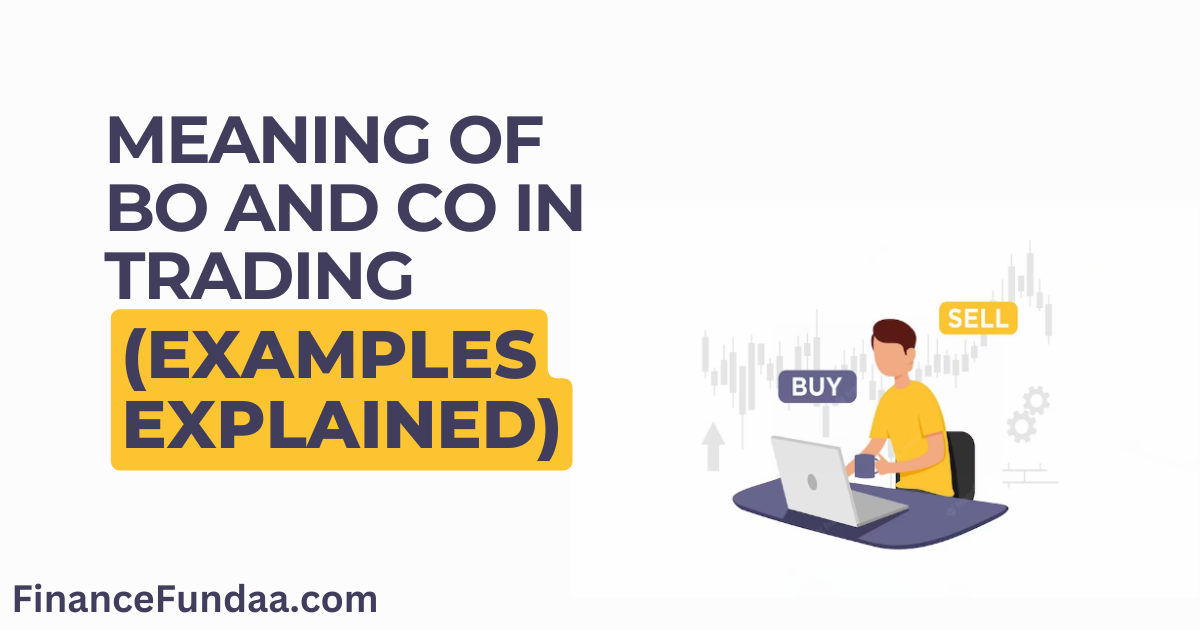Many of us are aware that trading apps have different types of trading orders. Bracket Orders (BO) and Cover Orders (CO) are the two most popular types of trading orders that help traders to increase trading flexibility and risk management capabilities. But the question is what is BO and CO in trading?
In short, BO and CO in trading are advanced trading techniques used to manage risk and improve efficiency in financial markets. These orders are particularly used in derivative trading, such as F&O.
In this article, we will understand the meaning of BO and CO in Trading, their examples, and their benefits in trading.
What is BO (Bracket Order) in trading?
A Bracket Order (BO) is a trading strategy that combines three orders into a single execution:
1. Entry order – It can be a market order or a limit order, depending on the trader’s strategy.
2. Target order – The target order is a limit order placed above the entry price. It is basically the profit target level that the trader aims to achieve. Once the market reaches this level, the target order is executed.
3. Stop-loss order – The stop-loss order is placed below the entry price to limit the losses. If the market moves against the trader’s position and reaches the stop-loss level, the order is executed at the pre-defined loss.
The purpose of using a BO is to establish predefined profit targets and loss limits while entering a position. It allows traders to automate their exit points, thus minimizing emotional decision-making during fast-moving market conditions.
Examples of BO
Imagine a trader who wants to buy shares of Tata Motors, which is currently trading at INR 500. The trader uses a Bracket Order strategy to execute an effective trade:
- Entry Order: The trader places a limit entry order to buy shares of ABC at INR 500.
- Target Order: The trader sets a profit target at INR 550, placing a limit sell order to automatically sell the shares if the price reaches this level.
- Stop-Loss Order: The trader sets a stop-loss at INR 490 to limit potential losses, placing a stop-market sell order that triggers if the price drops to this level.
If the price of ABC reaches INR 550, the Target Order is executed with a profit of INR 50. On the other hand, if the price drops to INR 490, the Stop-Loss Order is triggered, limiting the potential loss to INR 10.
What is CO (Cover Order) in trading?
Cover Orders (CO) are another type of trading order, where two orders are placed together. i.e.,:
Primary Order: The primary order can be a market order or a limit order. This order is executed immediately in the market.
Cover Order: The cover order is a compulsory stop-loss order that is placed along with the primary order. The cover order is executed if the market moves against the trader’s position, limiting potential losses.
COs are primarily used for intraday trading and are designed to provide leverage and quick execution. COs are suitable for traders who want to capitalize on short-term price movements.
Examples of CO
A day trader who wants to capture short-term price movements in Crude Oil futures. Crude Oil is currently trading at $70, and the trader decides to use a Cover Order for quick execution and risk management.
- Primary Order: The trader places a market order to buy Crude Oil futures at $70.
- Cover Order: Simultaneously, the trader places a mandatory stop-loss order at $68 along with the primary order. This ensures that if the price drops to $68, the position is automatically exited with a loss of $2.
In this scenario, the trader benefits from leverage, allowing them to control a larger position with less capital. Additionally, the Cover Order acts as a safety net, preventing excessive losses if the trade doesn’t go as planned. The trader’s strategy relies on quick movements, making the Cover Order an effective tool for intraday trading.
Benefits of BO and CO in Trading
Risk Management: Both BO and CO orders provide a structured approach to managing risk with the stop-loss levels.
Emotion Control: BO and CO both work on the predefined profit targets and loss limits, this helps traders to make emotional decisions.
Intraday Trading: CO orders are particularly for intraday trading, where quick execution and leverage are essential.
Volatility: It’s crucial to consider market volatility when setting stop-loss and target levels. Excessive volatility could trigger the premature execution of these orders.
Brokerage Policies: Different brokers may have varying policies and charges associated with BO and CO orders. Traders should be aware of these costs.
Also Read: What is CE and PE in Option Trading 2023? Practical Examples
Conclusion
In conclusion, BO and CO in trading are advanced trading that provide traders with enhanced risk management and efficiency. By combining entry, target, and stop-loss orders in a BO or incorporating a cover order with the primary order in a CO, traders can manage volatile markets with emotional stability and confidence.
